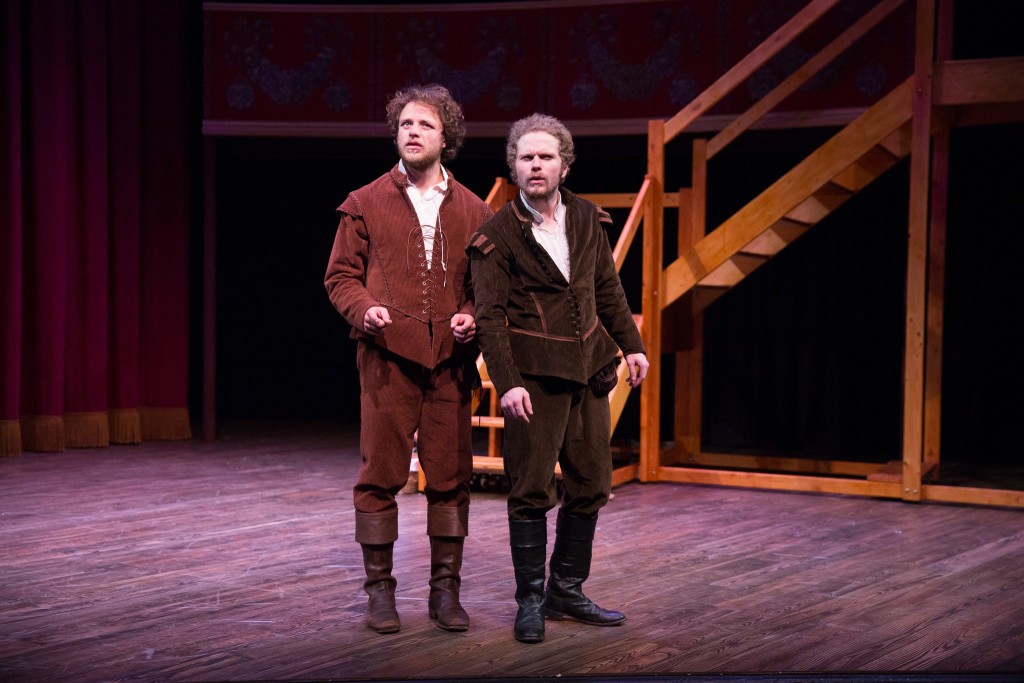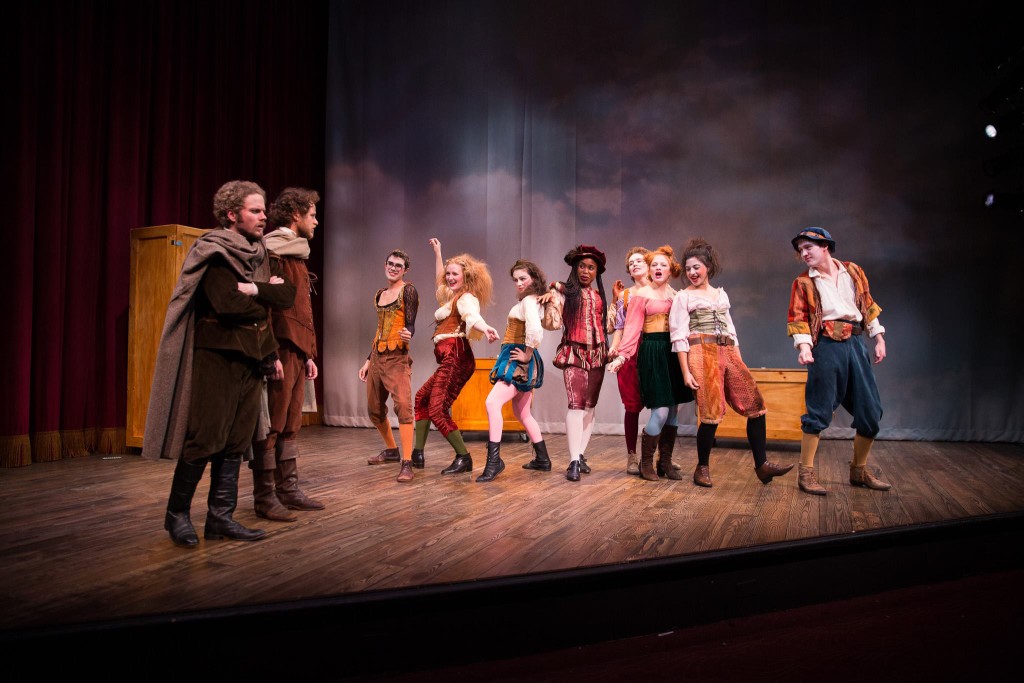
The minor characters of classic stories are having a moment. Since the premiere of Wicked on Broadway in 2003, and with the recent blockbuster film adaptation of Into the Woods, the whole mini-genre of pulling one-dimensional characters out of their famous tales and imbuing them with new heart has become quite the moneymaker. Given that recent success, it is refreshing to go back to one of the originals of this specific and witty art, Tom Stoppard’s ingenious 1966 tragicomedy Rosencrantz & Guildenstern Are Dead.
This play is a derivative of Shakespeare’s Hamlet, that illustrious, gorgeous drama of royal indecision. (For the few of you who occupy that intriguing cross-section of people who read drama reviews in campus arts magazines but are not familiar with Hamlet, Hamlet tells the tortured tale of the prince of Denmark. He wrestles with whether or not to pursue revenge against his uncle, who has murdered Hamlet’s father, married Hamlet’s mother and seized the throne.)
In the original play, Hamlet is paralyzed by the potential royal, familial, and lethal consequences that inevitably follow if he pursues any of his available options. Rosencrantz & Guildenstern, meanwhile, takes the most inconsequential characters from Shakespeare’s greatest tragedy and explores their profound unease at having no real decisions of consequence.
This is a more relatable predicament than that of Hamlet. We are much more likely to fear the apparent triviality of our existence than the decision of whether to kill our throne-usurping, mother-marrying uncle. As such, Rosencrantz & Guildenstern doesn’t just foreshadow the current trend of reworked bit players— it presciently subverts our human desperation for meaning. Instead of branching out beyond the confines of a well-known narrative, the play revels in the intended marginalia of its title characters, anarchically delighting in the absurdity of their being in the “title” at all. Stoppard foregoes the opportunity to construct new story blocks, and in doing so he paradoxically creates a more profound, meaningful play. He gleefully pokes his fingers in the holes of insignificance to explore that thinly veiled, communal, existential dread—our shared fear that the neat little designs we imagine for our lives could be so easily torn apart if investigated too thoroughly.
This quarter, Stanford theatre is diving headlong into that perilous investigation, with Rosencrantz & Guildenstern running through this Sunday at Pigott and Hamlet picking up in repertory on March 5th. This first show is the senior project of Max Walker-Silverman and Austin Caldwell, who star as Rosencrantz and Guildenstern, respectively. Directed by Amy Freed, this version of Stoppard’s classic revels in the absurd marginality of its aimless heroes, from the slightly off-kilter set design to the aching sincerity with which its stars deliver every line.

As Freed writes in the program notes, there is a “strange, challenging structure” to this play, “more like shards than architecture.” That fragmented structure captures the essence of life as accurately as dramatic architecture can. And in fully embracing the inherent ridiculousness of a play that elevates such inconsequential characters to the level of protagonist, this production hits all of Stoppard’s most subtle existential notes. Rosencrantz and Guildenstern’s ill-fated, energetically pursued attempts to parse out any significance in their lives becomes all the more tragic, as we in the audience become acutely and painfully aware there isn’t any.
The play opens on Rosencrantz and Guildenstern tossing coins in the air, the only people, action or thing in sight. They stand in front of a robust red curtain, which hangs ominously at the edge of Stage Right and suggests that we are not being allowed to see the more sensational shenanigans happening in Denmark at the moment. This curtain isn’t hiding the inner workings of any backstage; we are backstage, and Hamlet is talking to ghosts and plotting murder elsewhere.

For a few minutes it seems like the whole play will just be Walker-Silverman and Caldwell tossing coins back and forth, going off on nimbly-written tangents, wearing outfits of slightly different shades of brown and huge, distracting capes their characters don’t really know what to do with (they just sense that this accessory makes them “gentlemen”). The two actors, both slight in build and disheveled in hair, embody the two-peas-in-a-pod, barely-distinguishable-from-the-other dynamic of Rosencrantz and Guildenstern perfectly. They volley and catch Stoppard’s lithe prose so capably that their back-and-forth easily could have been the whole show.
It’s not, though, which is definitely for the best. One of the production’s treasures is Kasiemobi Udo-Okoye’s performance as the Player. As the leader of a band of misfit actors/prostitutes, which continually interrupts Rosencrantz and Guildenstern’s reveries like a deranged, sexually deviant Greek chorus, Udo-Okoye nearly steals the show.

She might run away with it completely if not for Walker-Silverman and Caldwell, as the ensemble cast sometimes struggles to keep up with its three stars. Still, the natural chemistry, existential and witty dynamism of Rosencrantz and Guildenstern’s conversations, and the Player’s interactions with them when she emerges to impart cheeky wisdom, are well worth the wait. The Player is as close to an oracle as Rosencrantz and Guildenstern ever get—or at least she is the only character who is distinctly aware of and comfortable with the role she is playing. Our purposeless heroes listen desperately to her every word, even as her explanations disturb them.
To the Player, art and mere life are “all the same”; there is a design at work, and all events must follow through to their “aesthetic, moral, and logical conclusions.” This view is especially troubling to Guildenstern, as he senses his own insignificance in that controlling schema and, consequently, feels the impending weight of his own death.
According to Shakespeare’s grand design, Rosencrantz and Guildenstern’s deaths are inevitable and logical. Stoppard respects this authorial intent to the point of profound discomfort. Part of the immense dread in the show comes from the anticipation of their deaths, coupled with the knowledge that these deaths are both destined and signify nothing. We are made acutely aware of Shakespeare’s grand design and kept uncomfortably far from its center, behind a heavy burgundy curtain, away from the meaning we crave.
There is still some comfort to be found in this. In exposing the fatalistic dark side of such deliberately constructed and “meaningful” worlds, Rosencrantz & Guildenstern makes a case for a life without a grand design. Pursue your whims; live your dreams. It’s probably for the best that your life wasn’t designed according to economic narrative principles, even by The Bard or that modern dramatic genius, Tom Stoppard. After all, what if they decide they don’t like you?
***
Rosencrantz & Guildenstern Are Dead is playing in Pigott Theater, February 19-21 at 8pm and February 22 at 2pm. Click here for tickets.
Photo credit: Frank Chen
